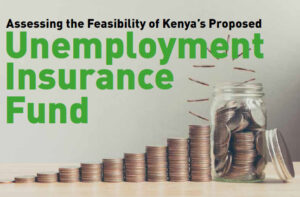Assessing the Feasibility of Kenya’s Proposed Unemployment Insurance Fund


Kenya is currently grappling with a challenging economic landscape characterised by a high cost of living, and the recent introduction of a housing levy has added to the financial burdens of employers and employees. Amid these economic challenges, the Unemployment Insurance Authority Bill, sponsored by Ikolomani MP Bernard Shinali, has gained prominence as it seeks to establish an Unemployment Insurance Fund (UIF) aimed at providing crucial financial support to employees who face job loss or their dependents.
At its core, the Unemployment Insurance Authority Bill, 2022 envisions the creation of a financial safety net for Kenyan workers. This fund is designed to act as a temporary financial cushion, offering relief to individuals confronted with unemployment until they secure new employment. To ensure effective administration, the proposed legislation also outlines the establishment of the Unemployment Insurance Authority, an autonomous body responsible for managing the fund, ensuring equitable resource allocation, and advising the government on unemployment insurance matters.
Kenya’s proposed UIF draws inspiration from South Africa, where a similar system has been in operation since April 2002. In South Africa, employees and employers contribute to the Unemployment Insurance Fund, with a few exceptions, such as part-time workers and certain government positions. Employees contribute 1% of their earnings, while employers match this with an additional 1%, resulting in a total contribution of 2%. This model provides temporary financial assistance to workers facing unemployment, illness, maternity, adoption, parental leave, or other eligible situations.
While the idea of establishing an Unemployment Insurance Fund in Kenya shows promise, several issues have been raised regarding its practical implementation.
Critics have questioned why only employees in the formal sector are subjected to this financial obligation, especially considering that a significant portion of the Kenyan workforce operates within the informal sector.
The cumulative deductions reflected on the majority of employee pay slips will exceed the two-thirds threshold. According to the Employment Act 2007, employers are prohibited from deducting more than two-thirds of an employee’s basic pay, aiming to protect their fair earnings from employment. Salaried workers have already witnessed an increase in NSSF contributions, soaring from KES 200 to as much as KES 1,080, in addition to the commencement of a 1.5% housing levy deduction based on their gross pay, resulting in a reduction of their net income. The introduction of an extra contribution to the UIF is poised to exacerbate this financial strain.
The UIF proposal is set to raise the wage bill, which will have an impact on companies’ operating costs and the criteria for firms to create new positions and enhance salaries. As the proposal exerts additional pressure on employees’ net income, it mandates employers to match employee contributions. This is anticipated to increase labour costs, compelling companies to contemplate implementing hiring freezes or, in some cases, downsizing their workforce. Simultaneously, employers may encounter demands for salary increases from employees aiming to offset the increased statutory deductions.
A significant challenge lies in distinguishing between individuals who lose their jobs due to company closures or winding up, and those labelled as “bad leavers.” This differentiation is crucial for ensuring an equitable distribution of benefits.
Kenya’s existing employment law already stipulates severance pay for employees in cases of redundancy. This has led to questions about how the proposed Unemployment Insurance Fund will coexist with these provisions and whether redundant workers will receive treatment equivalent to other unemployed individuals.
The proposed Unemployment Insurance Fund does not make distinctions between short-term and long-term employees, potentially raising concerns about whether this might undermine the incentive for individuals to remain gainfully employed.
Another issue is the uncertainty surrounding the potential establishment of minimum and maximum salary limits for contributions. In contrast, South Africa has implemented minimum and maximum income brackets for UIF contributions.
Ambiguity persists regarding whether the contributions to the fund will be treated as a tax and, consequently, whether they will be eligible for relief, set-off, adjustment, or refund.
The proposed Unemployment Insurance Fund represents a step toward providing financial security for workers in times of distress. However, its feasibility hinges on addressing the concerns raised by various stakeholders, its funding model, and ensuring that the fund is structured in a manner that supports those most in need. A meaningful social dialogue involving all parties may help build consensus on the best model for financing and implementing the UIF, ultimately ensuring its effectiveness in providing relief during times of economic uncertainty.

